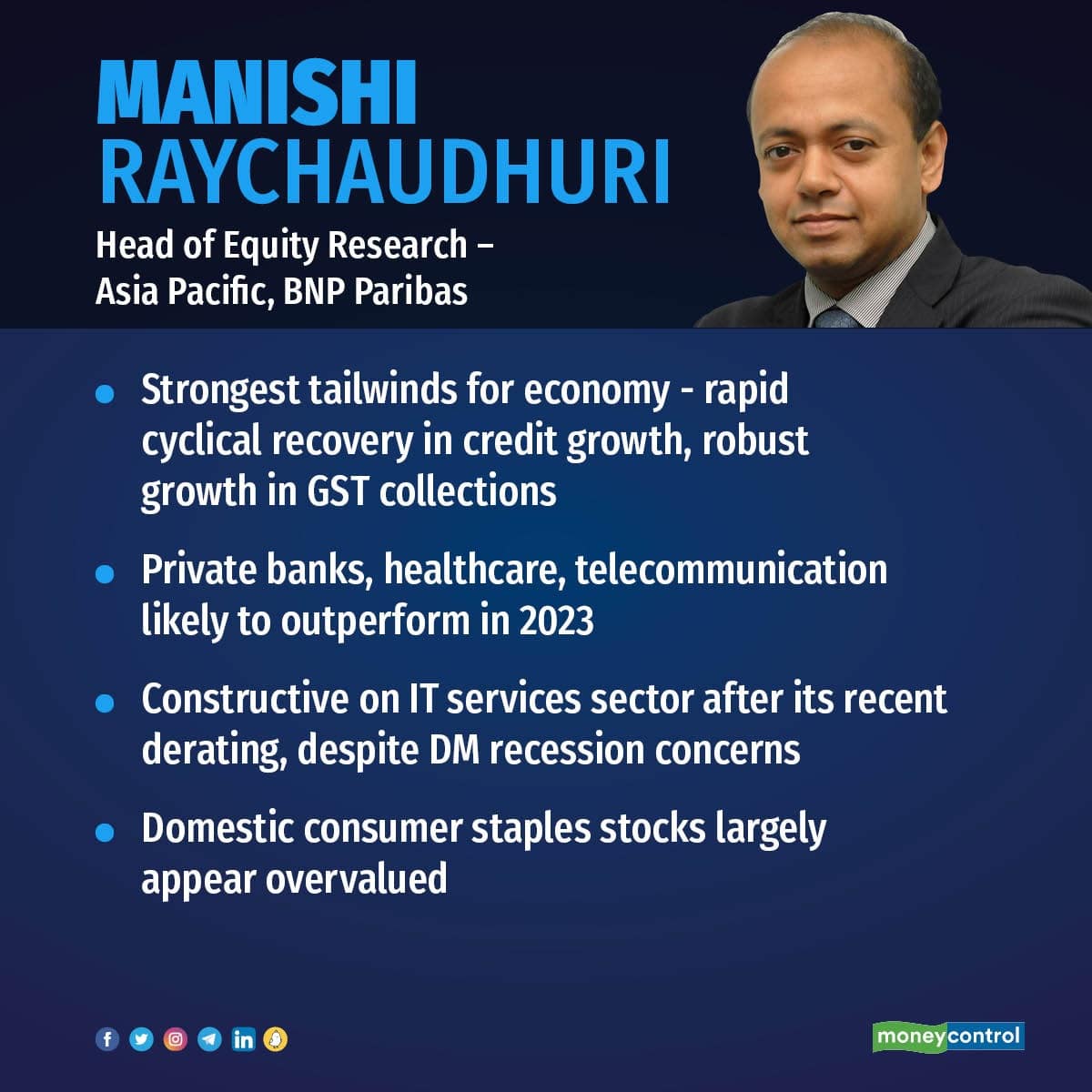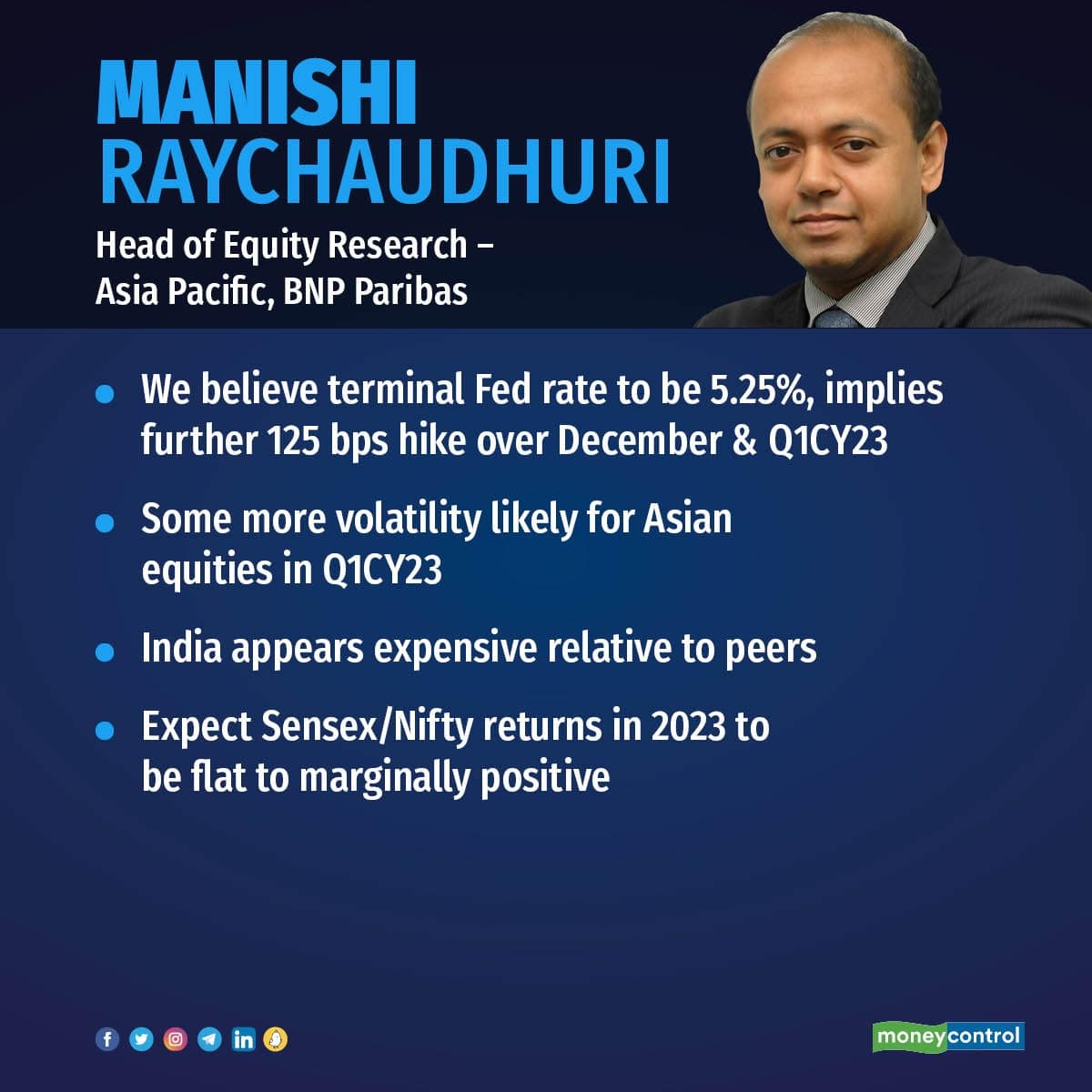
Manishi Raychaudhuri Asia-Pacific Head of Equity Research and Asian Equity Strategist – BNP Paribas (Image Source: Twitter/ @Manishi_R)
For the Indian economy, “the strongest tailwind is a rapid cyclical recovery apparent in strong credit growth revival and robust growth in GST collections,” says Manishi Raychaudhuri, Head of Equity Research – Asia Pacific at BNP Paribas Securities, in an interview to Moneycontrol.
He says vigorous expansion in FDI, driven by various supply-side measures adopted over the past 3-4 years is another notable support to the economy.
But BNP Paribas expects returns from India’s headline equity indices (Sensex and Nifty) in 2023 to be flat to marginally positive, as valuations adjust to relatively muted earnings growth expectations in a year of expected recession in Developed Economies, says Raychaudhuri.
He believes financials, particularly private banks, healthcare and telecommunication are likely to outperform in 2023.
With the rising hope that rate hikes by Federal Reserve may be slow, do you think the major worry for the market is behind us now?
A downshift on the part of the FOMC to a 50bps hike in December is widely expected in view of the lower-than-expected CPI print in October and the recent drop in energy prices. However, the BNP economics team still believes the terminal Fed rate shall be 5.25 percent – implying a further hike of 125 bps over December and the first quarter of 2023. Taken together with ongoing Quantitative Tightening (QT) by the Fed and the uncertainty surrounding China’s pivot away from the Zero Covid stance, we think some more volatility could be in store for Asian equities in Q1 2023.
Do you expect 2023 to be the best year for Indian equities compared to 2022?
Also read: Domestic investors do about-turn, sell equities worth Rs 6,300 crore in November
In the backdrop of a sharp drawdown in emerging market (EM) equities in 2022, Indian equities have performed quite well this year. Even when measured in USD terms Sensex and Nifty are down just about 2.5 percent in 2022, compared to a 25-30 percent decline in North Asian equities.
Barring Singapore, India is the best-performing market in Asia this year.

Consequently, India appears expensive relative to peers – in fact, India’s valuation premium relative to Asia ex-Japan is currently more than two standard deviations higher than the long-term mean.
We expect returns from India’s headline equity indices in 2023 to be flat to marginally positive, as valuations adjust to relatively muted earnings growth expectations in a year of expected recession in Developed Economies.
What are the biggest tailwinds for the economy and corporate earnings?
For the Indian economy, the strongest tailwind is a rapid cyclical recovery apparent in strong credit growth revival and robust growth in GST collections. Vigorous expansion in FDI, driven by various supply-side measures adopted over the past 3-4 years is another notable support to the economy.
Also read: Manufacturing PMI edges up to 55.7 in November, cost pressures soften considerably
What are the possible risks that are yet to be priced in by the equity market?
In a recessionary environment in developed economies, as we expect 2023 to be, Indian earnings, though relatively insulated from cross-border turmoil, would likely not be immune from downgrades. For instance, the consumption environment in India is largely supported by the urban affluent population employed primarily in the service sector. A developed market (DM) recession could negatively impact the revenues of these sectors, dampening the consumption sentiment.

Why do you think the broad private capex revival is unlikely before late 2023?
Average capacity utilisation in India, going by the RBI’s OBICUS survey, is about 73-75 percent. Only when this measure goes significantly beyond 80 percent do we think a broad private capex revival could ensue.
Which are the sectors that can outperform from here on? And also what is the reason for the cautious stance on domestic consumption?
We believe financials, particularly private banks, healthcare and telecommunication are likely to outperform in 2023. We are also constructive on the IT services sector after its recent derating, despite the DM recession concerns, as we believe the strong order flows for the frontline IT companies afford them revenue visibility in an uncertain environment. The domestic consumer staples stocks largely appear overvalued to us, particularly in view of the risk to their earnings from rural demand slowdown and input cost inflation.
Is it the right time to start adding positions in the technology space, the biggest underperformer in the current year?
Yes. Our reasons are explained in reply to the previous question.
Is it the time to add new-age stocks to a portfolio or should one wait for stability in earnings?
In an environment of revenue uncertainty and elevated cost of capital, we’d rather focus on stocks that are free cash generators and excess return generators. We believe for the outperformance of “long duration” stocks, i.e. those likely to generate positive cash flows far out in the future, investors would have to wait for a significant decline in the cost of capital.
Disclaimer: The views and investment tips expressed by investment experts on Moneycontrol.com are their own and not those of the website or its management. Moneycontrol.com advises users to check with certified experts before taking any investment decisions.
